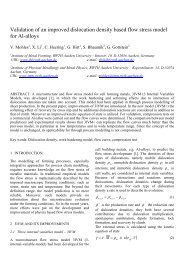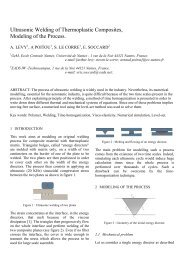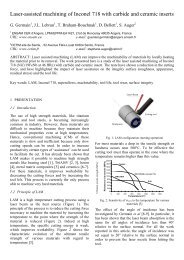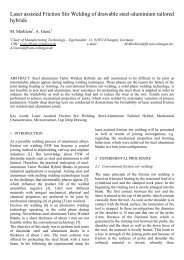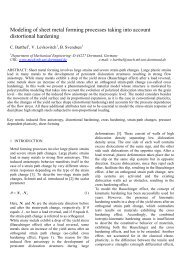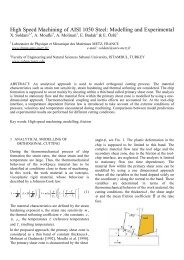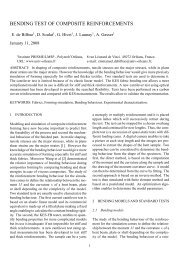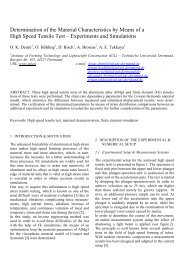Here - the ESAFORM 2008 Conference - INSA de Lyon
Here - the ESAFORM 2008 Conference - INSA de Lyon
Here - the ESAFORM 2008 Conference - INSA de Lyon
Create successful ePaper yourself
Turn your PDF publications into a flip-book with our unique Google optimized e-Paper software.
Investigation of friction in warm forging of AA6082B. Buchner, A. Weber, B. BuchmayrChair of Metal Forming, University of Leoben – Franz-Josef-Strasse 18, 8700 Leoben, AustriaURL: www.metalforming.at e-mail: metalforming@unileoben.ac.atABSTRACT: This paper presents an experimental investigation of friction in hot forging of AA6082, whichis a standard forging alloy in automotive engineering, mechanical engineering and in naval architecture, byemploying a modified ring-on-disc test. The experiments were performed with three different commercialgraphite-based lubricants and at various loads, sliding velocities and specimen surface conditions. In addition,some tests were performed without lubrication.KEYWORDS: Friction, Warm Forging, Aluminium1 INTRODUCTIONForged parts ma<strong>de</strong> of aluminium play a significantrole as components of light weight structures in <strong>the</strong>automotive and aerospace industry. The main parametersinfluencing forging processes are <strong>the</strong> flow curvesof <strong>the</strong> specimen material, <strong>the</strong> heat transfer at <strong>the</strong> contactarea and <strong>the</strong> friction in <strong>the</strong> die-workpiece interface[1, 2]. The exact knowledge of <strong>the</strong> latter is paidmuch attention to as it affects power requirements,material flow, die filling, tool life and workpiece quality.In or<strong>de</strong>r to un<strong>de</strong>rstand <strong>the</strong> tribological processesand interactions in <strong>the</strong> tool-workpiece interface, <strong>the</strong>influences of <strong>the</strong> load collective and <strong>the</strong> surface conditionson friction were investigated systematically. Theexperiments were performed with a facility based on<strong>the</strong> ring-on-disc test introduced by Schey [3].2 EXPERIMENTAL WORKforce is realised by ano<strong>the</strong>r load cell, <strong>the</strong> rotationalspeed of <strong>the</strong> specimen is calculated from <strong>the</strong> speed of<strong>the</strong> servo motor. The specimen is brought to forgingtemperature by an inductive heating system, whereas<strong>the</strong> tool is heated by a heating sleeve. The lubricantis sprayed onto <strong>the</strong> tool by an automatic applicationsystem that allows a reproducible dosing. The testing<strong>de</strong>vice is controlled by a programmable logic controlunit (PLC), <strong>the</strong> data acquisition is realised by a measurementamplifier that is connected to a commercialpersonal computer.The tribometer has a maximum upsetting force of approximately100 kN and provi<strong>de</strong>s a maximum torqueof more <strong>the</strong>n 800 Nm on <strong>the</strong> rotary disc. The rotationalspeed can be up to 1.7 s −1 . The sliding distanceis not constrained by <strong>the</strong> testing <strong>de</strong>vice. Themaximum temperature of <strong>the</strong> specimen is 1200 °C,<strong>the</strong> maximum temperature of <strong>the</strong> tool is 450 °C. Thetemperatures can be kept constant in an interval of±2.5 °C.2.1 Testing <strong>de</strong>viceFigure 1 shows <strong>the</strong> Rotational Forging Tribometer.The circular motion is supplied from <strong>the</strong> bottom si<strong>de</strong>by means of a servo motor and a bevel gear system.The compression force is applied by a hydraulic cylin<strong>de</strong>rfrom <strong>the</strong> top si<strong>de</strong>. The specimen (workpiece)is mounted on a rotary disc and transmits <strong>the</strong> frictionaltorque to <strong>the</strong> pivot-mounted ring-shaped tool.The tool is supported by a load cell via a lever armwhich enables an accurate measurement of <strong>the</strong> frictionaltorque. The acquisition of <strong>the</strong> compressionFigure 1: Rotational Forging Tribometer.1



